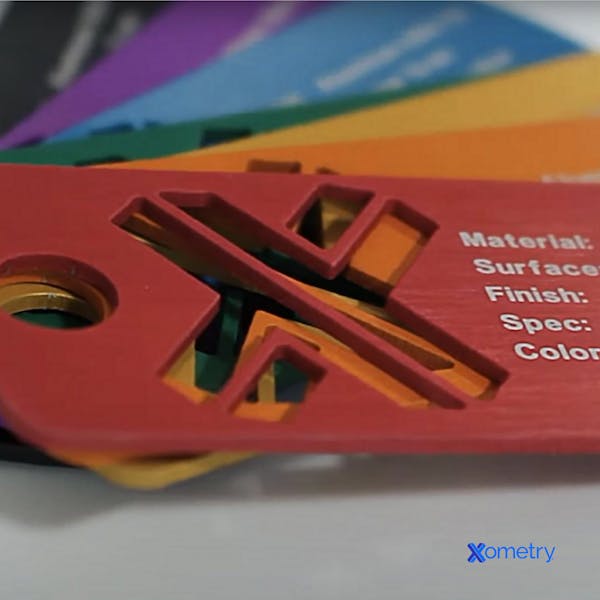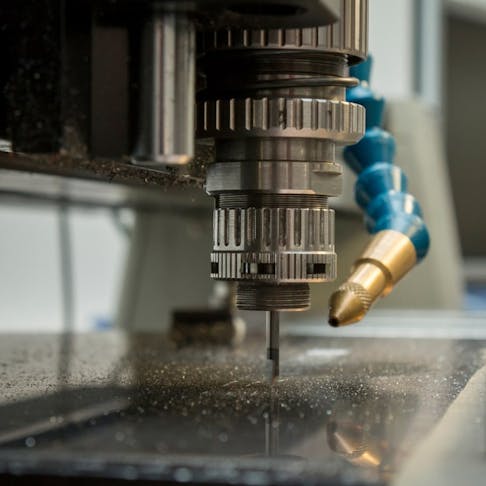Engraving was a historically important means of producing images on paper in artistic printmaking, mapmaking, and commercial reproductions and illustrations for the publishing industry. Various photographic processes have long replaced it in its commercial applications and, partly because of its complexity, is much less common in printmaking and has been largely replaced by etching and other techniques. However, engraving is still common in other industries.
Metal engraving is used to mark text, logos, pictures, numbers, 2D codes, and more. The industries that engrave metal include jewelry, medical, automotive, aeronautics, and energy, to name a few. Engraving is the process of creating letters, lines, or designs by incising surfaces. Engraving can be used on a variety of materials such as glass, plastic, and stone, but this article will focus on metals.

Metal Engraving Methods
The following methods are common processes performed in most engraving shops.
Diamond-Drag Scratch Engraving
This process uses a non-rotating tool with a cone-shaped diamond tip. The engraving tool is dragged through the metal part, leaving an impression. Diamond-drag creates quality and precise engraving that compares to hand engraving. The width of the stroke is constant and does not vary in depth. Diamond drag is recommended for soft metals and is ideal for engraving jewelry and trophies.
The benefits of this method are that it is generally the fastest form of engraving, is the least expensive, and the width of the stroke allows for small engraved letters. One drawback is that it has a limited stroke width.
Burnishing
Burnishing uses a rotating tool with limited pressure. The tool is either carbide or a diamond cutter of varying tip width that removes the top coating or layer of material and creates a smooth, polished finish. Burnishing can stand in for situations where diamond drag is used. Burnishing is still a newer process for many shops.
The benefits of burnishing are the virtually unlimited stroke width and the larger letter heights that can be achieved. Some drawbacks are that it is more expensive and requires a noisy engraving motor and an additional burnishing adapter.
Rotary Engraving
This method uses a single or multiple fluted cutting tool that rotates through metal parts to remove material, leaving a trough of the exposed core. It results in a deeper cut or the complete cut-out of a letter or object. In most applications, the spindle micrometer setting controls the depth of the cut. The process is suitable for most commercial and industrial work.
Rotary engraving is the most permanent form of engraving and allows virtually any size of letter to be created, and can achieve two- and three-dimensional appearances. Some drawbacks are that it requires a broader selection of cutting tools, a rotary spindle, and a motor, and generally requires more clean-up.
Laser Beam Engraving
A laser engraver can cut, engrave, or mark metal materials. The laser beam physically removes the metal’s surface to create a cavity that reveals an image at eye level. The laser beam produces high heat during the process, which essentially causes the substance to vaporize.
The benefits of laser engraving are that it allows for more detailed images, cleaner cuts, it’s faster, it’s fairly affordable, and it doesn’t create waste such as sawdust. The drawbacks are that thicker materials are more difficult for laser cutting or require very low speeds, and the laser burns the edges of any material being cut. A laser engraving machine can also use a lot of energy, increasing the production cost.
Engraved Metals
Some of the most commonly engraved metals are:
Aluminum
Brightly coated or anodized aluminum is used to make plaques or trophy plates. Machining grade aluminum is used to construct control panels, interior and exterior signage, and industrial applications. Its surface can be temperamental compared to brass, copper, and bronze. However, almost all aluminum alloys will cut with some experimentation and patience.
Brass
Commercially purchased brass is hard to engrave. “Engravers Brass” or “half-hard” brass is much softer and can be found at engraving material suppliers. For deep cut signage, brass with a thickness of .040-.060 in. is recommended. This metal can be paint-filled for contrast between the letters and the brass background. Laser etching brass creates a bold black mark on the metal alloy, making it a very commonly marked metal.
Stainless Steel
Stainless steel is harder to engrave but has many benefits. It is very durable, corrosion-resistant, moisture-resistant, and doesn't contaminate other materials. It is used in food processing plants and hospitals where a reaction or corrosion would destroy most metals. Its other applications include containers, control panels, switch and legend plates, signs, and elevator panels.
When cutting stainless steel, a collet spindle is one of the most important tools. The collet spindle with a split collet grabs the cutting tool vary close to the work area. This extra rigidity will allow for deeper cuts and less cutter chipping or breaking. Laser engraving cannot be used on steel as the heat from the laser removes an important protective layer, but laser annealing can.
Gold, Silver, Pewter
These metals are soft and are easily cut. They work well for gift items in most engraving applications, such as jewelry personalization, and diamond drag engraving is the method of choice. These materials can be deep cut easily with the same cutting tools used for brass. In most cases, no cutting fluids are necessary.
The Difference Between Metal Laser Engraving and Laser Marking
Laser marking uses a focused laser beam to alter the surface of the workpiece permanently. Unlike laser engraving, it changes the metal’s surface without removing material. As a result, it creates long-lasting high-contrast marks that can easily be read or scanned. The four most commonly used laser marking methods are annealing, carbon migration, coloring, and foaming. A metal marking compound is sometimes applied before laser marking to allow easier marking and higher contrast mark.
Fiber or galvanometer laser systems are typically used to mark bare metals and engineered plastics. These lasers have different wavelengths than CO2 lasers, which allow them to mark bare metals without using metal marking agents. While laser marking and laser engraving are terms often used interchangeably as laser processes, they differ.
As explained above, laser engraving is a manufacturing process that uses a laser beam to remove material from the metal to form the desired design. The results are durable and resistant to falsification. The three most common laser cutting techniques are laser etching, laser engraving, and laser ablation. The main difference between etching and engraving and ablation is that laser etching produces shallow marks, while laser engraving creates deep marks that are more durable.
Summary
Metal engraving techniques are useful to provide for permanent part marking and tagging of products across different industries. We hope this guide has provided you with a better understanding of the metal engraving methods that exist and the different materials to which these methods apply.
Do you have a project that includes engraving services or any other types of part marking? You can get an instant quote on parts today. Additionally, check out our full range of capabilities for part marking, finishing services, and more.
Disclaimer
The content appearing on this webpage is for informational purposes only. Xometry makes no representation or warranty of any kind, be it expressed or implied, as to the accuracy, completeness, or validity of the information. Any performance parameters, geometric tolerances, specific design features, quality and types of materials, or processes should not be inferred to represent what will be delivered by third-party suppliers or manufacturers through Xometry’s network. Buyers seeking quotes for parts are responsible for defining the specific requirements for those parts. Please refer to our terms and conditions for more information.
Sources:


